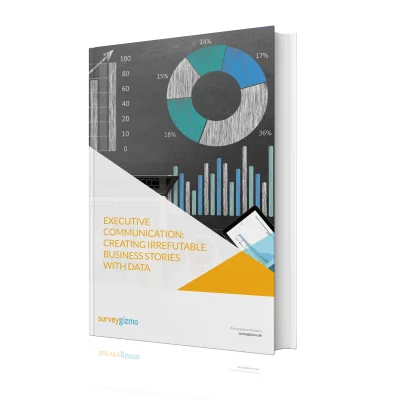Highlights
- We just published Executive Communication: Creating Irrefutable Business Stories With Data e-book.
- Inside the data visualization best practice guide learn the power of storytelling, why to leverage decision-modeling, and how to architect an easily digestible data dashboard.
- This resource was co-authored with business intelligence and data science experts Donald Farmer from TreeHive Strategy and Nicholas Kelly from NickSight.
Why do we use data visualization?
Put simply, data visualizations are the best way to communicate the insights derived from data analysis. In today’s business landscape, it’s more important than ever to make data-backed decisions, yet many of us lack the skills needed to extract actionable insights from raw data.
Using a visualization to relay what a given dataset says is a growing technique for stakeholders to effectively understand, reason, and form a decision backed by comprehensive data sets.
Communicating data findings to key stakeholders is a top challenge.
We recently surveyed 500 CEOs, CTOs, executives, engineers, directors and professionals across industries. The study revealed that while organizations have plenty of data to work with, nearly 50 percent said they’re only “sometimes” able to communicate data insights to key stakeholders.
Communicating to executives takes well-honed tact and poise. When it comes to trying to communicate the language of data when it’s typically presented in flat non-contextual spreadsheets and in ill supported graphics, businesses trying to become more data-driven are hitting a brick wall.
Supporting the data using insightful visuals helps to remove this wall, but not without its own learning curve.
To solve for the intimidating challenge of translating data into something actionable, 82.2 percent of those we surveyed say they are planning on investing in visualization tools within the next year.
But before any investment decision can be made or even considered, it’s best to first take time to understand why visualizing data makes good business sense and what it can do for strategic decision-making.
What is a dashboard in data analytics?
A dashboard is a visual at-a-glance customized view of data insights and metrics. Dashboards are typically connected to a backend data set that feeds information it needs to then translate and render the data into predetermined visual representations such as charts or graphs.
One major advantage of having a dashboard, which should be treated in any organization as a living product that evolves over time, is that it allows users to easily see high-level insights that can be used in determining decisions.
Dashboards also provide a view into what is happening in a given area of the business at any time and does not need to wait on time sinking reports.
“Thinking of your dashboard designs as ‘decision support’ does not mean you are taking a step [back] in time,” says Donald Farmer, Principal at TreeHive Strategy. “Rather, it means you are focussed on exactly what your users need. With this focus, you will build analytic experiences that are grounded in the real data and the real workflow of your business. Meaningful insights and better decisions will flow.”
The need for data visualization skill sets in business is growing and becoming standard operating practice.
It’s been said that data is nothing without visualization. And when you think about the amount of data produced every day, reportedly around 2.5 quintillion bytes, knowing visualization basics will only help businesses:
- Create operational efficiencies
- Increase productivity and profit
- Unveil untapped markets
Just as businesses seek to hire top talent in functions like sales, marketing, and customer service as part of standard operating practice, having data science skills in-house is proving to be more of a priority as the pressure to become holistically data-driven is on many 2018 agendas.
To become a data-driven company, you don’t need all the data, you need the right data.
More, in this case, is not better. Businesses often struggle with the data they have available simply because it’s overwhelming; they don’t know where to begin. But when you take a step back and ask what would benefit the business in the long-term, this approach should help you narrow in on the data sets that can be leveraged to achieve your main goal.
Find out what questions are consistently left unanswered and then find the right datasets to help support the solution for those challenges.
By leveraging the data that already is in your business and identifying the areas that you may need more data for, you will begin to naturally develop a path forward toward data-driven decision modeling.
From there, you will being to build a visual dashboard, but only after you have determined what decisions will be made from it — not before. If you build a dashboard before understanding what decisions need to made from it, the dashboard will be a waste of time, money, and effort as it would be less likely to be beneficial or valuable.





